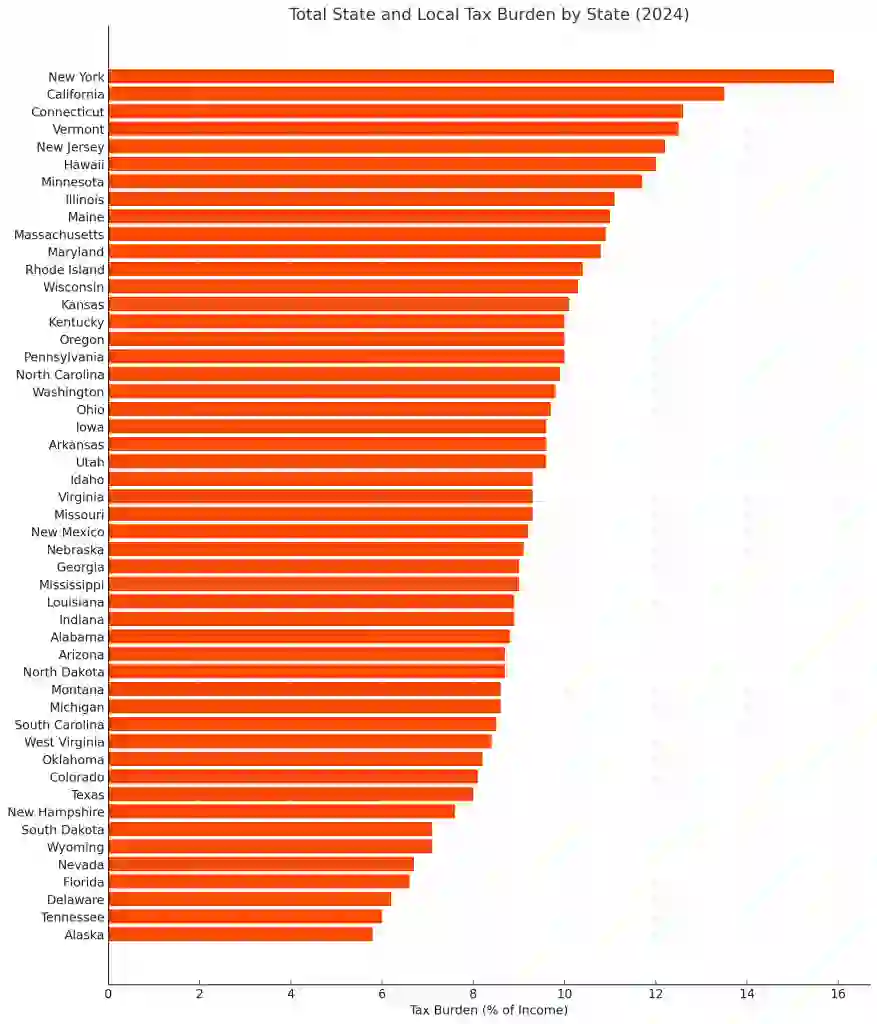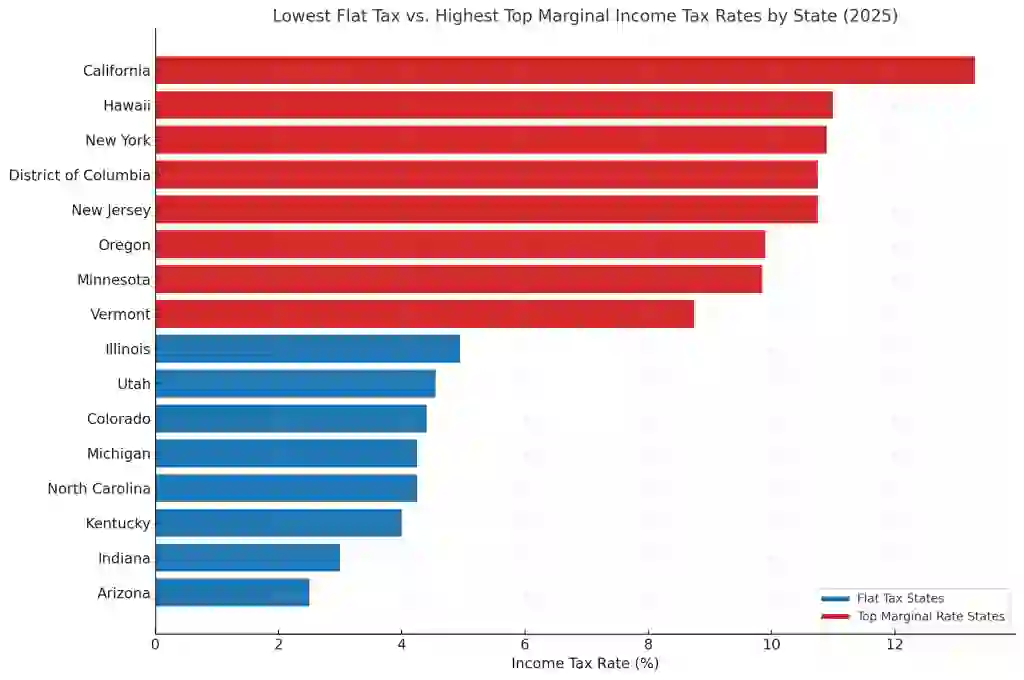State Income Tax Rates in 2024 and 2025: A Complete Guide

Commitment to Our Readers
GOBankingRates' editorial team is committed to bringing you unbiased reviews and information. We use data-driven methodologies to evaluate financial products and services - our reviews and ratings are not influenced by advertisers. You can read more about our editorial guidelines and our products and services review methodology.

20 Years
Helping You Live Richer

Reviewed
by Experts

Trusted by
Millions of Readers
If you’re planning a move, budgeting for next year, or simply wondering how much of your paycheck is going to the state, understanding state income tax rates is essential. These rates vary widely across the U.S. and can impact everything from your take-home pay to your long-term financial goals.
Whether you live in a state with no income tax or one with some of the highest progressive brackets, this guide will help you compare state income tax rates in 2024 and 2025 so you can make more informed decisions.
What Is State Income Tax?
State income tax is a tax levied by individual states on your earnings, separate from federal income tax.
The amount you owe depends on where you live, how much you earn and how your state structures its tax system. States use this money to fund essential services like education, infrastructure and public safety.
There are three main systems:
- No Income Tax: A handful of states charge nothing on personal income.
- Flat Tax: One rate applies to all taxpayers, regardless of income level.
- Progressive Tax: Rates increase as income rises, similar to the federal system.
Which States Have the Highest and Lowest Income Tax?
For 2025, the states with the highest top-income tax rates are California (13.3%), Hawaii (11%) and New York (10.9%), where the rich pay more.
Some states, like Arizona, Georgia and Illinois, charge a flat tax across all income levels. Meanwhile, nine states, including Florida, Texas and Washington, don’t tax income at all.
What Are the Different Types of State Income Tax Systems?
Here’s how the three main types compare:
| System Type | How It Works | Example States |
|---|---|---|
| None | No personal income tax | Florida, Texas, Wyoming |
| Flat | Single rate applies to all income levels | Colorado, Illinois, Kentucky |
| Progressive | Rates increase with higher income levels | California, New York, Minnesota |
Most states use a progressive model, but several have transitioned to flat taxes in recent years.
Most states use a progressive tax system, where your tax bracket increases if you earn a higher income. For example, someone earning $30,000 yearly may pay a lower rate than someone earning $100,000.
In flat tax states, however, everyone pays the same state income tax rate across the board, no matter how much income they earn.
Meanwhile, a few states have no state income taxes at all — often charging higher sales tax or property taxes to compensate.
Understanding How State Income Taxes Work
Even if two states have similar tax rates, their rules about who pays and what’s taxed can vary widely.
Who Pays State Income Tax?
Whether or not you owe state income tax generally depends on your residency status and where your income was earned:
- Residents: Many states require full-time residents to pay state income tax on all income, even if some of it was earned in another state.
- Part-year residents: If you lived in one state for part of the year and moved to another, you’ll likely need to file taxes in both states.
- Nonresidents: If you work in a different state than where you live, you may owe taxes there, along with your home state.
How States Tax Non-Wage Income
Along with wages and salaries, many states also tax non-wage income, such as:
- Capital gains when you sell stocks or real estate.
- Interest and dividends that you earn from savings accounts or investments.
- Retirement income, including Social Security, pensions, IRA and 401(k) distributions.
That said, how states treat this income varies, with some states offering complete exemptions, especially for retirees. For example, Florida and Texas don’t tax individual income at all, including non-wage income.
States With No Income Tax
Nine states currently don’t tax earned income:
- Alaska
- Florida
- Nevada
- New Hampshire (taxes interest and dividends)
- South Dakota
- Tennessee
- Texas
- Washington (taxes capital gains)
- Wyoming
Although no state income tax sounds great in theory, there are some important trade-offs to be aware of.
Taxes fund essential state services, like schools, transportation and public services — so states with no income tax have to make up the difference elsewhere, like by charging higher sales, property or capital gains taxes. Their cost of living or housing market could also be more expensive, offsetting their 0% state income tax rates.
So, just because a state doesn’t charge income tax doesn’t necessarily mean you’re going to save money overall. For example, even though Washington doesn’t tax income, it still ranks 30th in overall tax burden among the 50 states, according to the Tax Foundation.

States With Flat Tax Rates
With flat tax rates, you pay the same tax rate no matter how much income you earn. This system is typically simpler than progressive tax structures, but critics argue that it unfairly burdens low and middle-class taxpayers.
While some states have used the flat tax system for a long time, others have recently shifted from progressive to flat tax to make it easier for the government to predict incoming revenue and for citizens to estimate their tax liability.
Here are the states that impose a flat tax rate on their citizens:
- Arizona: 2.5%
- Colorado: 4.4%
- Georgia: 5.39%
- Idaho: 5.7%
- Illinois: 4.95%
- Indiana: 3%
- Iowa 3.8%
- Kentucky: 4%
- Louisiana: 3%
- Michigan: 4.25%
- Massachusetts: 5% (4% surtax on income over $1,083,150 in 2025)
- Mississippi: 4.4%
- North Carolina: 4.25%
- Pennsylvania: 3.07%
- Utah: 4.55%
States With Graduated-Rate Income Taxes
With graduated (or progressive) tax rates, most states have separate tax brackets that depend on how much you earn. The idea is that people in higher income brackets can afford to pay more taxes. However, more brackets can lead to more complexity.
Here’s how progressive state income tax rates break down by several brackets:
States with Two to Three brackets
- Alabama: 3 brackets (2% to 5%) — income range: $500 to $6,001
- Kansas: 2 brackets (5.2% to 5.58%) — up to/over $46,000
- Maine: 3 brackets (5.8% to 7.15%) — $26,800 to $63,450
- Mississippi: 2 brackets (0% to 4.7%) — income over $10,001 taxed at flat 4.7%
- Montana: 2 brackets (4.7% to 5.9%) — $21,100 to $42,200
- North Dakota: 3 brackets (1.95% to 2.5%) — $60,000 to $225,975
- Ohio: 3 brackets (0% to 3.5%) — $0 to $115,300
- Rhode Island: 3 brackets (3.75% to 5.99%) — $0 to $181,650
- South Carolina: 3 brackets (0% to 6.2%) — Varies by income level
States with Four to Five brackets
- Minnesota: 4 brackets (5.35% to 9.85%) — $30,070 to $183,341
- Nebraska: 4 brackets (2.46% to 5.2%) — $2,999 to $58,000
- New Mexico: 5 brackets (1.5% to 5.9%) — $8,000 to $315,000
- Oregon: 4 brackets (4.75% to 9.9%) — Varies by income level
- Vermont: 4 brackets (3.35% to 8.75%) — Varies by income level
- Virginia: 4 brackets (2% to 5.75%) — Varies by income level
- West Virginia: 5 brackets (2.22% to 4.82%) — $5,000 to $60,000
- Wisconsin: 4 brackets (3.5% to 7.65%) — Varies by income level
States with Six or more brackets
- Arkansas: 5 brackets (0% to 3.9%) — up to $89,601
- Connecticut: 7 brackets (2% to 6.99%) — up to $1,000,001
- Delaware: 7 brackets (2.2% to 6.6%) — up to $60,001
- District of Columbia: 7 brackets (4% to 10.75%) — $10,000 to $1 million+
- Hawaii: 12 brackets (1.4% to 11%) — up to $650,001
- Maryland: 8 brackets (2% to 5.75%) — $1,000 to $250,000
- Missouri: 8 brackets (0% to 4.7%) — $1,273 to $8,911
- New Jersey: 7 brackets (1.4% to 10.75%) — $20,000 to $1 million
- New York: 9 brackets (4% to 10.9%) — Varies by income level
- California: 9 brackets (1% to 13.3%), plus 1% mental health surcharge on income over $1 million — $10,099 to $698,271
States With the Highest Top Marginal Income Tax Rates
A marginal tax rate is the extra tax you pay on each dollar you earn above a certain income threshold — not your entire income. For example, if the top rate kicks in at $1 million, only the income above that amount is taxed at that rate.
The top marginal state income tax rate is the highest rate that a state can apply to individual income. As of 2025, here are the states with the highest top marginal state income tax rates:
- California: 13.3%
- Hawaii: 11%
- New York: 10.9%
- New Jersey: 10.75%
- Oregon: 9.9%
Side Note: It’s important to note that the top marginal income tax rate isn’t the same as a state’s overall tax burden. Remember:
- The top marginal rate is the highest percentage a state applies to taxable income above a certain threshold.
- A state’s tax burden, on the other hand, shows the total amount of taxes the residents pay (including income, sales, property and other state or local taxes).
States with the Lowest Flat Income Tax Rates
Some states use a flat tax system, where all taxable income is taxed at the same rate, no matter how much you earn.
This system can make filing your taxes a lot easier, since there’s only one rate to worry about, and you don’t have to adjust for income level as you do with progressive systems.
Among the states that do have an income tax, the following have the lowest flat tax income rates as of 2025:
- Arizona: 2.5%
- Indiana: 3%
- Louisiana: 3%
- Pennsylvania: 3.07%
- Kentucky: 4%
Here’s a comparison of the states with the lowest flat income tax rates and the states that have the highest top marginal income tax rates (from the last section):

State Income Tax Rates Comparison
Below is a table you can use to compare income tax rates across all 50 states. These rates typically apply to single filers, not married couples filing jointly. States with a range use progressive tax brackets, while single percentage values represent flat tax rates.
| State | 2024 Tax Rate | 2025 Tax Rate | Tax System Type |
|---|---|---|---|
| Alabama | 2% – 5% | 2% – 5% | Progressive |
| Alaska | No state income tax | No state income tax | None |
| Arizona | 2.5% | 2.5% | Flat |
| Arkansas | 2% – 4.4% | 2% – 3.9% | Progressive |
| California | 1% – 13.3% | 1% – 13.3% | Progressive |
| Colorado | 4.25% | 4.4% | Flat |
| Connecticut | 2% – 6.99% | 2% – 6.99% | Progressive |
| Delaware | 2.2% – 6.6% | 2.2% – 6.6% | Progressive |
| District of Columbia | 4% – 10.75% | 4% – 10.75% | Progressive |
| Florida | No state income tax | No state income tax | None |
| Georgia | 5.49% | 5.39% | Flat |
| Hawaii | 1.4% – 11% | 1.4% – 11% | Progressive |
| Idaho | 5.8% | 5.7% | Flat |
| Illinois | 4.95% | 4.95% | Flat |
| Indiana | 3.05% | 3% | Flat |
| Iowa | 4.4% – 5.7% | 3.8% | Flat |
| Kansas | 3.1% – 5.7% | 5.2% – 5.58% | Progressive |
| Kentucky | 4% | 4% | Flat |
| Louisiana | 1.85% – 4.25% | 3% | Flat |
| Maine | 5.8% – 7.15% | 5.8% – 7.15% | Progressive |
| Maryland | 2% – 5.75% | 2% – 5.75% | Progressive |
| Massachusetts | 5% – 9% | 5% – 9% | Flat |
| Michigan | 4.25% | 4.25% | Flat |
| Minnesota | 5.35% – 9.85% | 5.35% – 9.85% | Progressive |
| Mississippi | 0% – 4.7% | 0% – 4.7% | Progressive |
| Missouri | 2% – 4.8% | 2% – 4.7% | Progressive |
| Montana | 4.7% – 5.9% | 4.7% – 5.9% | Progressive |
| Nebraska | 2.46% – 5.84% | 2.46% – 5.2% | Progressive |
| Nevada | No state income tax | No state income tax | None |
| New Hampshire | No state income tax* | No state income tax | None |
| New Jersey | 1.4% – 10.75% | 1.4% – 10.75% | Progressive |
| New Mexico | 1.7% – 5.9% | 1.5% – 5.9% | Progressive |
| New York | 4% – 10.9% | 4% – 10.9% | Progressive |
| North Carolina | 4.5% | 4.25% | Flat |
| North Dakota | 1.95% – 2.5% | 1.95% – 2.5% | Progressive |
| Ohio | 2.75% – 3.5% | 2.75% – 3.5% | Progressive |
| Oklahoma | 0.25% – 4.75% | 0.25% – 4.75% | Progressive |
| Oregon | 4.75% – 9.9% | 4.75% – 9.9% | Progressive |
| Pennsylvania | 3.07% | 3.07% | Flat |
| Rhode Island | 3.75% – 5.99% | 3.75% – 5.99% | Progressive |
| South Carolina | 0% – 6.3% | 0% – 6.2% | Progressive |
| South Dakota | No state income tax | No state income tax | None |
| Tennessee | No state income tax | No state income tax | None |
| Texas | No state income tax | No state income tax | None |
| Utah | 4.55% | 4.55% | Flat |
| Vermont | 3.35% – 8.75% | 3.35% – 8.75% | Progressive |
| Virginia | 2% – 5.75% | 2% – 5.75% | Progressive |
| Washington | No state income tax* | No state income tax* | None |
| West Virginia | 2.36% – 5.12% | 2.22% – 4.82% | Progressive |
| Wisconsin | 3.5% – 7.65% | 3.5% – 7.65% | Progressive |
| Wyoming | No state income tax | No state income tax | None |
*Note: Although neither state taxes wages or salaries, Washington imposes a 7% tax on long-term capital gains over $270,000 as of 2024 while New Hampshire charges a 3% tax on interest and dividends as of 2025.
When Are State Income Tax Returns Due?
Most state income tax returns follow the federal deadline, which is typically April 15. However, a few states set their own deadlines, for example:
- Hawaii set its 2024 tax year deadline for April 21.
- Virginia gives residents extra time, with returns due by May 1.
- Louisiana often extends its deadlines to May 15.
It’s important to note that an extension on your federal tax return doesn’t automatically mean an extension on your state deadline.
Check your state’s official tax agency to find the most up-to-date information. You can find a full list of state tax agency websites on the Federation of Tax Administrators website.
Filing Taxes With Multiple State Income Tax Rates
If you live in one state but earn income in another, you may need to file more than one state return. Here are some common scenarios that could require multiple-state filing:
- You moved mid-year and earned income in both your old and new states.
- You work remotely for a company based in another state.
- You own rental property in a different state that generates income.
If you work remotely, check if your home state and your employer’s state have a reciprocity agreement. This could allow you to:
- Request that your nonresident state exempt you from your tax withholdings.
- Have your employer withhold taxes for your home state.
- Make estimated tax payments to your resident state.
If there’s no reciprocity agreement, you’ll have to file a nonresident return for your employer’s state and a resident return for your home state. However, you’ll usually receive a tax credit from your state of residence for any taxes you pay to any nonresident states.
Let’s look at a quick example:
If you live in California but earn $10,000 in Kansas, you’ll have to report the $10,000 in income to both states. Since Kansas taxes income under $15,000 at 3.1%, you would owe about $310. When you file with California, the state will also tax that $10,000, but you’ll get a credit for the $310 you already paid to Kansas, reducing how much you owe in California.
Here are some helpful resources you can use to help you when filing in multiple states:
- IRS Schedule CR: If you earn income in multiple states, you can use your home state’s specific form to claim a credit if you’ve already paid taxes in another state.
- IRS Form 1040-NR: If you’re not a U.S. resident but earned income here, whether through wages, investments or business income, you may need to file this form.
- Multi-state income tax calculator: Some free tools, like TaxSlayer, may help you estimate how much tax you owe across multiple states.
Planning for State Income Taxes
Knowing the difference between state and federal income taxes can serve you well when creating a budget or considering a move.
Since each state has its unique tax structure and rates, it’s important to know how these rules will impact your income when it comes to financial planning. Here are a few important tips to remember:
- Consider tax implications before relocating: Although no income tax states may sound appealing, check that other taxes and the cost of living don’t outweigh 0% state income tax rates.
- Factor state taxes into retirement planning: Some states don’t tax Social Security benefits, pensions or withdrawals from your 401(k) and IRA, which could make them ideal places to move when you retire.
- Remote workers may owe taxes in more than one state: If you work remotely for a company based in another state or move mid-year, you may have to file in multiple states.
Remember, it’s always a good idea to consult with your tax professional if you have questions about your specific situation. They can also help you with potential deductions, credits and tax refund opportunities to maximize your savings.
Final Take to GO: State Income Taxes Vary — Know Yours Before You File or Move
No matter where you live, state income tax rates play a major role in your financial picture — especially if you’re moving, earning income in multiple states or budgeting for the year ahead.
The key takeaway?
- Some states won’t tax your income at all, while others may take up to 13%.
- Flat tax states simplify filing, but may not always mean lower taxes.
- Progressive states can significantly increase your bill as your income rises.
Before you relocate, plan your budget or file your taxes, use the tables above to compare your options. Knowing how your state stacks up can help you make smarter financial decisions.
FAQs About State Income Tax Rates
Knowing your state income tax rates goes a long way when judging your paycheck:- Which states have no income tax?
- As of 2025, nine states including Texas, Florida and Tennessee have no personal income tax.
- What’s the difference between flat and progressive tax systems?
- Flat taxes apply one rate to all income; progressive systems increase rates as income rises.
- Can I pay income tax in more than one state?
- Yes. If you live, work or earn income in multiple states, you may need to file in each.
- Do all states follow the April 15 tax deadline?
- Most do, but some have different due dates. Always confirm with your state.
- How do state taxes affect my move?
- Moving to a lower-tax state can lower your overall tax burden -- but consider property taxes, sales taxes and cost of living too.
Information is accurate as of May 14, 2025.
Editorial Note: This content is not provided by any entity covered in this article. Any opinions, analyses, reviews, ratings or recommendations expressed in this article are those of the author alone and have not been reviewed, approved or otherwise endorsed by any entity named in this article.
Writer Instructions
-
Primary Keyword: state income tax rates
-
Secondary Keyword(s) if applicable:
-
State tax rates comparison
Highest state income taxes
No state income tax states
Income tax brackets by state
State tax rates 2024
-
-
Word count: 1500
-
Inspo URL:
Income Tax by State: 2024 Rates and Brackets - NerdWallet
-
Must haves: (make sure these are 2025 related, NW piece is 2024, but use as format inspo)
-
Introduction: Overview of State Income Tax Rates
-
Briefly explain what state income taxes are and how they vary by state.
-
Mention that some states have no income tax, while others use progressive tax brackets.
-
-
Understanding How State Income Taxes Work
-
Offer a simple breakdown of how state income tax systems function, including flat taxes vs. progressive tax brackets.
-
Provide examples of states with each type, like Illinois (flat tax) vs. California (progressive tax).
-
-
States with No Income Tax
-
List the states that do not have an income tax, such as Texas, Florida, and Nevada.
-
Discuss the trade-offs, like reliance on other taxes (e.g., sales taxes or property taxes).
-
-
States with the Highest Income Tax Rates
-
Identify states with the highest income tax rates (e.g., California, New York, and Oregon).
-
Provide specific tax brackets for these states and offer examples of how income is taxed at different levels.
-
-
State Income Tax Rates Comparison Table
-
Include a clear, easy-to-read comparison table that shows tax rates across all states.
-
Provide side-by-side data for quick reference, including brackets, rates, and income thresholds.
-
-
How State Income Taxes Affect Taxpayers
-
Explain how state taxes influence taxpayers' take-home pay, particularly for residents in states with high rates or no income tax.
-
Discuss the tax implications of moving between states with different tax policies.
-
-
Filing Taxes with Multiple State Income Tax Rates
-
Provide advice for individuals who work or live in multiple states during the year, and how to file taxes accordingly.
-
Mention common tax credits or deductions for cross-state filers.
-
-
Conclusion: Planning for State Income Taxes
-
Summarize the importance of understanding state income taxes and how they impact financial planning.
-
Suggest readers stay updated on yearly changes to tax rates and laws.
-
-
- Federation of Tax Administrators "Tax Rates."
- Tax Foundation "The State Flat Tax Revolution: Where Things Stand Today."
- Business Insider "State income taxes rates for Tax Day 2024 (2023 tax year)."
- TurboTax - Intuit "States with the Lowest Taxes and the Highest Taxes"
- IRS "About taxpayer burden reduction"
 Written by
Written by  Edited by
Edited by 
























